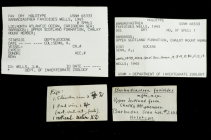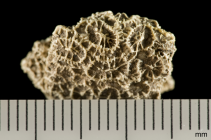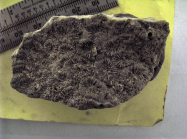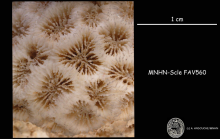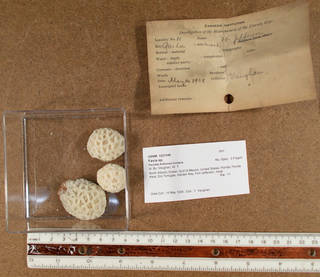
| About | | Search taxa | | Taxon tree | | Search literature | | Checklist | | Stats | | Log in |
WoRMS taxon detailsFavia De Blainville, 1820
718691 (urn:lsid:marinespecies.org:taxname:718691)
accepted
Genus
Astraea (Favia) de Blainville, 1820 · unaccepted > superseded combination
Astrea (Favia) Blainville, 1820 · unaccepted > junior subjective synonym
Barbadiastrea Wells, 1945 † · unaccepted > junior subjective synonym
Clypeofavia de Angelis d'Ossat, 1894 † · unaccepted > junior subjective synonym
Favia Milne Edwards & Haime, 1857 · unaccepted > junior homonym
Favia Oken, 1815 · unaccepted > unavailable name
Fissicella Dana, 1848 † · unaccepted > junior subjective synonym
Stegiastrea Meneghini, 1857 † · unaccepted > junior subjective synonym
marine,
Blainville, H.M. de. (1820). Mollusques, Vers et Zoophytes, EUP-FIK. <em>Dictionnaire des Sciences Naturelles.</em> 16: 1-567, Levrault, Strasbourg et Paris. [details]
Nomenclature Named after Favia Oken, 1815, which is invalid
Nomenclature Named after Favia Oken, 1815, which is invalid [details] Description Colonies are usually massive, either flat or dome-shaped. Corallites are monocentric and plocoid: each corallite projects...
Description Colonies are usually massive, either flat or dome-shaped. Corallites are monocentric and plocoid: each corallite projects slightly above the colony surface and has its own wall. Daughter corallites are formed by intratentacular division. Polyps are extended only at night and have a simple circle of tapering tentacles, often with a pigmented tip (Veron, 1986). [details]
Hoeksema, B. W.; Cairns, S. (2024). World List of Scleractinia. Favia De Blainville, 1820. Accessed through: World Register of Marine Species at: https://www.marinespecies.org/aphia.php?p=taxdetails&id=718691 on 2024-07-27
Date action by
original description
Blainville, H.M. de. (1820). Mollusques, Vers et Zoophytes, EUP-FIK. <em>Dictionnaire des Sciences Naturelles.</em> 16: 1-567, Levrault, Strasbourg et Paris. [details]
original description (of Favia Oken, 1815) Oken, L. (1815-1816). Lehrbuch der Naturgeschichte. Dritter Theil: Zoologie. <em>Erste Abtheilung: Fleischlose Thiere,Leipzig: C.H. Reclam & Jena: A. Schmid, [book (3rd vol part one, of 3 vols, including plates atlas of T.1, 1813].</em> xxviii + 842 pp. + xviii, 40 pls. L [copepods 180-184, 357-359, 4 plates]., available online at http:// https://doi.org/10.5962/bhl.title.166403 [details] original description (of Barbadiastrea Wells, 1945 †) Wells JW. (1945). American Old and Middle Tertiary larger foraminifera and corals. Part II. West Indian Eocene and Miocene corals. <em>Geological Society of America Memoir.</em> 9 (2): 1-25, pls. 1-3. [details] original description (of Clypeofavia de Angelis d'Ossat, 1894 †) de Angelis d'Ossat, G. (1894). I corallari dei terreni terziari dell'Italia settentrionale. <em>Atti della reale Academia Lincei, Memorie Classe Scienze fisiche matematiche e naturali, Ser 5a.</em> 1: 164-279, 3 pls. [details] basis of record Baron-Szabo, R. C. (2018). Nomenclatural notes on the genus Favia (Anthozoa: Scleractinia: Faviina: Faviidae). <em>Proceedings of the Biological Society of Washington.</em> 131(1): 197-201., available online at https://doi.org/10.2988/18-00006 [details] additional source Gohar, H.A.F. (1940). Studies on the Xeniidae of the Red Sea: their ecology, physiology, taxonomy and phylogeny. <em>Publications of the Marine Biological Station, Ghardaqa (Red Sea).</em> 2: 25-118, plates 1-7. page(s): 42 [details] additional source Verrill, A. E. (1868-1870). Review of the corals and polyps of the west coast of America. <em>Transactions of the Connecticut Academy of Arts and Sciences.</em> 1, 6, 377-558. page(s): 512 [details] additional source Maragos, J. E.; Molina, M.; Kenyon, J. (2004). Palmyra Atoll coral data compiled from Townsend Cromwell 2000-2002, U.S. Fish and Wildlife Service 2000-2001, and Sette 2004 surveys [Table 8]. UNPUBLISHED, UNPUBLISHED [details] additional source Maragos, J. E.; Kenyon, J. (2004). Rose Atoll coral data compiled from US Fish and Wildlife Service 1994, Townsend Cromwell 2002, and Sette 2004 surveys [Table 10]. UNPUBLISHED, Unpublished page(s): 1 [details] additional source Sheppard, C. R. C. (1985). Fringing reefs in the southern region, Jeddah to Jizan. Fauna of Saudi Arabia, 7, 37-58 page(s): 45 [details] additional source Ono, S.; Reimer, J. D.; Tsukahara, J. (2007). Thriving cnidarian community on the volcanic coastline of Sakurajima Taisho Lava Field, southern Japan. Coral Reefs, 26, 95 page(s): 95 [details] additional source Tkachenko, K. S.; Wu, B. J.; Fang, L. S.; Fan, T. Y. (2007). Dynamics of a coral reef community after mass mortality of branching Acropora corals and an outbreak of anemones. Marine Biology, 151, 185-194 page(s): 187 [details] additional source Veron JEN, Pichon M, Wijsman-Best M. (1977). Scleractinia of Eastern Australia – Part II. Families Faviidae, Trachyphylliidae. <em>Australian Institute of Marine Science Monograph series.</em> 3: 1-233. page(s): 27, 29, 48, 49, 50 [details] additional source Budd AF, Fukami H, Smith ND, Knowlton N. (2012). Taxonomic classification of the reef coral family Mussidae (Cnidaria: Anthozoa: Scleractinia). <em>Zoological Journal of the Linnean Society.</em> 166 (3): 465-529., available online at https://doi.org/10.1111/j.1096-3642.2012.00855.x [details] additional source Matthai G. (1914). A revision of the recent colonial Astraeidae possessing distinct corallites. <em>Transactions of the Linnean Society of London, 2nd Series Zoology.</em> 17(1): 1-140, pls. 1-38. page(s): 113-115 [details] additional source Yabe H, Sugiyama T. (1935). Revised list of the reef-corals from the Japanese seas and of the fossil reef corals of the raised reefs and the Ryukyu limestone of Japan. <em>Journal of the Geological Society of Japan.</em> 42: 379-403. page(s): 388, 390 [details] additional source Milne Edwards H, Haime J. (1857). Histoire naturelle des coralliaires ou polypes proprement dits 2. Librairie Encyclopédique de Roret, Paris. 631 pp., available online at https://www.biodiversitylibrary.org/page/12403706 [details] additional source Bassett-Smith, P.W. (1890). Report on the corals from Tizard and Macclesfield Banks, China Sea. <em>Annals and Magazine of Natural History,.</em> 6(35): 353-374, 443-458, pls. 12-14., available online at https://doi.org/10.1080/00222939008694050 page(s): 358, 372 [details] additional source Fromentel, E. de. (1861). Introduction a l'etude des polypiers fossiles. <em>Memoires de la Societe d 'Emulation du Departement du Doubs.</em> 1-157. [details] additional source Veron JEN, Marsh LM. (1988). Hermatypic corals of Western Australia : records and annotated species list. <em>Records Western Australian Museum Supplement.</em> 29: 1-136., available online at https://doi.org/10.5962/bhl.title.60555 page(s): 28, 101 [details] additional source Durham JW. (1962). Corals from the Galapagos and Cocos Islands. <em>Proceedings of the California Academy of Sciences, Fourth Series.</em> 32 (2): 41-56. page(s): 45 [details]  Present Present  Inaccurate Inaccurate  Introduced: alien Introduced: alien  Containing type locality Containing type locality
Nontype BMNH, geounit Vietnamese Exclusive Economic Zone [details]
Nontype WAM 231-83, geounit Australian Exclusive Economic Zone [details]
Nontype WAM 247-83, geounit Australian Exclusive Economic Zone [details]
From editor or global species database
Biology zooxanthellate [details]Nomenclature Named after Favia Oken, 1815, which is invalid [details] From other sources
Description Colonies are usually massive, either flat or dome-shaped. Corallites are monocentric and plocoid: each corallite projects slightly above the colony surface and has its own wall. Daughter corallites are formed by intratentacular division. Polyps are extended only at night and have a simple circle of tapering tentacles, often with a pigmented tip (Veron, 1986). [details]
To European Nucleotide Archive, ENA (Favia) (from synonym Favia Oken, 1815)
To European Nucleotide Archive, ENA (Favia) To European Nucleotide Archive, ENA (Favia) (from synonym Favia Milne Edwards & Haime, 1857) To NMNH Extant Collection (IZ COE USNM 1221349 fragments) To NMNH Extant Collection (IZ USNM 10929 top view) |
